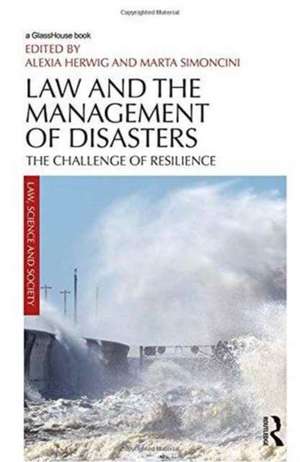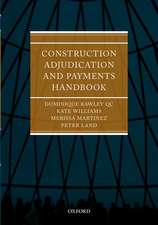Law and the Management of Disasters: The Challenge of Resilience: Law, Science and Society
Editat de Alexia Herwig, Marta Simoncinien Limba Engleză Hardback – 15 dec 2016
| Toate formatele și edițiile | Preț | Express |
|---|---|---|
| Paperback (1) | 301.33 lei 6-8 săpt. | |
| Taylor & Francis – 15 iun 2018 | 301.33 lei 6-8 săpt. | |
| Hardback (1) | 765.43 lei 6-8 săpt. | |
| Taylor & Francis – 15 dec 2016 | 765.43 lei 6-8 săpt. |
Din seria Law, Science and Society
-
 Preț: 293.95 lei
Preț: 293.95 lei - 18%
 Preț: 143.89 lei
Preț: 143.89 lei -
 Preț: 293.72 lei
Preț: 293.72 lei -
 Preț: 281.67 lei
Preț: 281.67 lei -
 Preț: 405.39 lei
Preț: 405.39 lei -
 Preț: 469.34 lei
Preț: 469.34 lei -
 Preț: 409.48 lei
Preț: 409.48 lei - 12%
 Preț: 301.33 lei
Preț: 301.33 lei -
 Preț: 389.38 lei
Preț: 389.38 lei -
 Preț: 416.22 lei
Preț: 416.22 lei - 20%
 Preț: 356.45 lei
Preț: 356.45 lei -
 Preț: 384.70 lei
Preț: 384.70 lei -
 Preț: 389.38 lei
Preț: 389.38 lei -
 Preț: 389.66 lei
Preț: 389.66 lei -
 Preț: 373.59 lei
Preț: 373.59 lei -
 Preț: 389.66 lei
Preț: 389.66 lei - 9%
 Preț: 937.23 lei
Preț: 937.23 lei
Preț: 765.43 lei
Preț vechi: 1028.14 lei
-26% Nou
Puncte Express: 1148
Preț estimativ în valută:
146.47€ • 156.62$ • 122.12£
146.47€ • 156.62$ • 122.12£
Carte tipărită la comandă
Livrare economică 17 aprilie-01 mai
Preluare comenzi: 021 569.72.76
Specificații
ISBN-13: 9781138193529
ISBN-10: 1138193526
Pagini: 292
Ilustrații: 10
Dimensiuni: 156 x 234 x 21 mm
Greutate: 0.52 kg
Ediția:1
Editura: Taylor & Francis
Colecția Routledge
Seria Law, Science and Society
Locul publicării:Oxford, United Kingdom
ISBN-10: 1138193526
Pagini: 292
Ilustrații: 10
Dimensiuni: 156 x 234 x 21 mm
Greutate: 0.52 kg
Ediția:1
Editura: Taylor & Francis
Colecția Routledge
Seria Law, Science and Society
Locul publicării:Oxford, United Kingdom
Public țintă
Postgraduate and UndergraduateCuprins
Underpinning the Role of Law in Disaster Resilience, Marta Simoncini and Alexia Herwig Part I Risk Assessment in the Light of Resilience 1. Multi-Risk Analysis: A New Paradigm for Territorial Resilience, Sara Bouchon and Carmelo Dimauro 2. Resilience in Retrospect: Interpreting Fukushima’s Disappearing Consequences, John Downer 3. Resilience and International (Quasi-)Judicial Bodies in Water Cases: An Uneasy Relationship?, Mónika Ambrus Part II Risk Regulation under Resilience 4. Disaster Risk Regulation in the European Union. The Path to Resilience, Marta Simoncini 5. Risk Regulation and Resilience in Offshore Oil and Gas Operation, Preben H Lindøe 6. Smart cities and the challenge of resilience, Carmelo Dimauro Part III Disaster Relief and Resilience 7. Resilience and Responsibility in International Law: The Achievements of the Sendai Framework through the Example of Climate Change, Alexia Herwig 8. Governing from a Distance: European Union Foreign Policy and Resilience Building, Jonathan Joseph 9. Resilience Strategy in the United States. Incentivizing Resilient Practices and Behaviour, David A Trissell Part IV In the aftermath. Towards resilient recovery 10. The Resilient Constitution: Lessons from the Financial Crisis, Xenophon Contiades and Alkmene Fotiadou 11. Tort law as an Instrument for the Prevention and Remediation of Catastrophic Harm, Monika Hinteregger 12. Resilient Compensation Mechanisms. The Role of Government Intervention in the Insurance of Catastrophic Risks, Michael Faure and Tobias Heldt Conclusions - One Law to Bind them All: International Law and Disaster Resilience, Emanuele Sommario
Descriere
Disasters raise serious challenges for contemporary legal orders: they demand significant management, but usually amidst massive disruption to the normal functioning of state authority and society. This book analyses the contribution of law to resilience building by looking at law’s role in the different phases of the disaster regulatory process: risk assessment, risk management, emergency intervention, and recovery; addressing how law can effectively contribute to resilience-oriented distaster management policies, and what legal instruments can support effective resilience-building.











